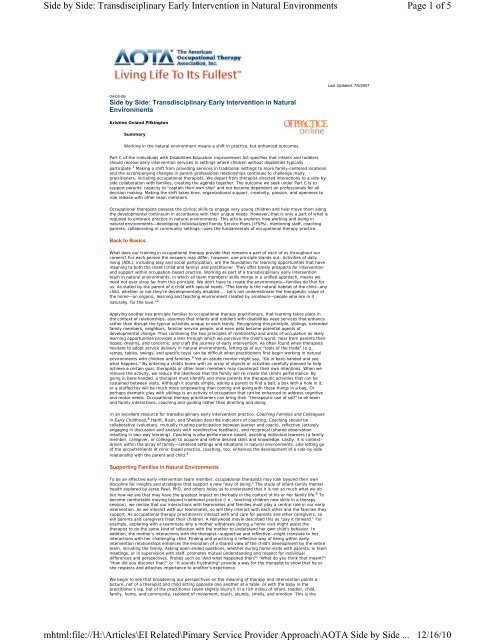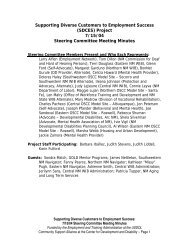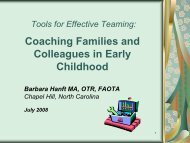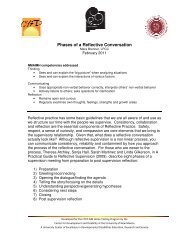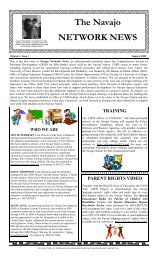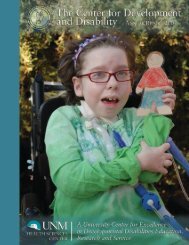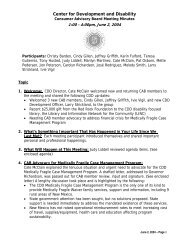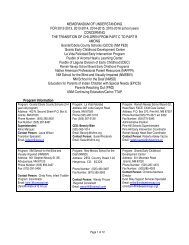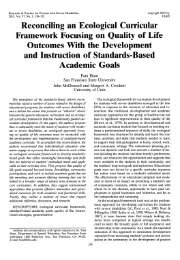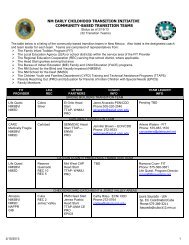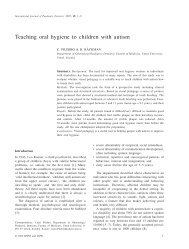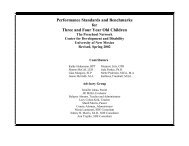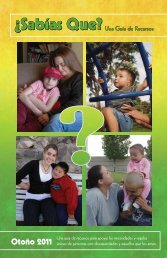AOTA - Side by Side - Center for Development and Disability
AOTA - Side by Side - Center for Development and Disability
AOTA - Side by Side - Center for Development and Disability
Create successful ePaper yourself
Turn your PDF publications into a flip-book with our unique Google optimized e-Paper software.
<strong>Side</strong> <strong>by</strong> <strong>Side</strong>: Transdisciplinary Early Intervention in Natural Environments<br />
04-03-06<br />
<strong>Side</strong> <strong>by</strong> <strong>Side</strong>: Transdisciplinary Early Intervention in Natural<br />
Environments<br />
Kristine Ovl<strong>and</strong> Pilkington<br />
Summary<br />
Working in the natural environment means a shift in practice, but enhanced outcomes.<br />
Part C of the Individuals with Disabilities Education Improvement Act specifies that infants <strong>and</strong> toddlers<br />
should receive early intervention services in settings where children without disabilities typically<br />
participate. 1 Making a shift from providing services in traditional settings to more family-centered locations<br />
<strong>and</strong> the accompanying changes in parent-professional relationships continues to challenge many<br />
practitioners, including occupational therapists. We depart from therapist-directed interactions to a side-<strong>by</strong>side<br />
collaboration with families, creating the agenda together. The outcome we seek under Part C is to<br />
support parents' capacity to "captain their own ship" <strong>and</strong> not become dependent on professionals <strong>for</strong> all<br />
decision making. Making the shift takes time, organizational support, creativity, passion, <strong>and</strong> openness to<br />
role release with other team members.<br />
Occupational therapists possess the clinical skills to engage very young children <strong>and</strong> help move them along<br />
the developmental continuum in accordance with their unique needs. However, that is only a part of what is<br />
required to embrace practice in natural environments. This article explores how working <strong>and</strong> being in<br />
natural environments—developing Individualized Family Service Plans (IFSPs), mentoring staff, coaching<br />
parents, collaborating in community settings—uses the fundamentals of occupational therapy practice.<br />
Back to Basics<br />
What does our training in occupational therapy provide that remains a part of each of us throughout our<br />
careers? For each person the answers may differ; however, one principle st<strong>and</strong>s out: Activities of daily<br />
living (ADL), including play <strong>and</strong> social participation, are the foundation <strong>for</strong> learning opportunities that have<br />
meaning to both the client (child <strong>and</strong> family) <strong>and</strong> practitioner. They offer timely prospects <strong>for</strong> intervention<br />
<strong>and</strong> support within occupation-based practice. Working as part of a transdisciplinary early intervention<br />
team in natural environments, in which all team members' skills merge in a unified approach, means we<br />
need not ever stray far from this principle. We don't have to create the environments—families do that <strong>for</strong><br />
us. As stated <strong>by</strong> the parent of a child with special needs, "The family is the natural habitat of the child—any<br />
child, whether or not they're developmentally disabled.... Let's not underestimate the therapeutic value of<br />
the home—an organic, learning <strong>and</strong> teaching environment created <strong>by</strong> amateurs—people who are in it<br />
naturally, <strong>for</strong> the love." 2<br />
Applying another key principle familiar to occupational therapy practitioners, that learning takes place in<br />
the context of relationships, assumes that infants <strong>and</strong> toddlers with disabilities need services that enhance<br />
rather than disrupt the typical activities unique to each family. Recognizing this principle, siblings, extended<br />
family members, neighbors, familiar service people, <strong>and</strong> even pets become potential agents of<br />
developmental change. Thus combining the two principles of relationship <strong>and</strong> areas of occupation as likely<br />
learning opportunities provides a lens through which we perceive the child's world; hear from parents their<br />
hopes, dreams, <strong>and</strong> concerns; <strong>and</strong> craft the journey of early intervention. As often found when therapists<br />
hesitate to adopt service delivery in natural environments, letting go of our "tools of the trade" (e.g.,<br />
ramps, tables, swings, <strong>and</strong> specific toys) can be difficult when practitioners first begin working in natural<br />
environments with children <strong>and</strong> families. 3 Yet an astute mentor might say, "Go in bare-h<strong>and</strong>ed <strong>and</strong> see<br />
what happens." By entering a child's home with an array of objects or activities carefully planned to help<br />
achieve a certain goal, therapists or other team members may counteract their own intentions. When we<br />
remove the activity, we reduce the likelihood that the family will re-create the child's per<strong>for</strong>mance. By<br />
going in bare-h<strong>and</strong>ed, a therapist must identify <strong>and</strong> show parents the therapeutic activities that can be<br />
sustained between visits. Although it sounds simple, asking a parent to find a ball, a box with a hole in it,<br />
or a stuffed toy will be much more empowering than coming <strong>and</strong> going with these things in a bag. Or<br />
perhaps dramatic play with siblings is an activity of occupation that can be enhanced to address cognitive<br />
<strong>and</strong> motor needs. Occupational therapy practitioners can bring their "therapeutic use of self" to all team<br />
<strong>and</strong> family interactions, coaching <strong>and</strong> guiding rather than directing <strong>and</strong> doing.<br />
In an excellent resource <strong>for</strong> transdisciplinary early intervention practice, Coaching Families <strong>and</strong> Colleagues<br />
in Early Childhood, 4 Hanft, Rush, <strong>and</strong> Shelden describe indicators of coaching. Coaching should be<br />
collaborative (voluntary, mutually trusting participation between learner <strong>and</strong> coach), reflective (actively<br />
engaging in discussion <strong>and</strong> analysis with nondirective feedback), <strong>and</strong> reciprocal (shared observation<br />
resulting in two-way learning). Coaching is also per<strong>for</strong>mance-based, assisting individual learners (a family<br />
member, caregiver, or colleague) to acquire <strong>and</strong> refine desired skills <strong>and</strong> knowledge. Lastly, it is contextdriven<br />
within the array of family—centered settings <strong>and</strong> situations in natural environments. Like letting go<br />
of the accoutrements of clinic-based practice, coaching, too, enhances the development of a side-<strong>by</strong>-side<br />
relationship with the parent <strong>and</strong> child. 4<br />
Supporting Families in Natural Environments<br />
To be an effective early intervention team member, occupational therapists may look beyond their own<br />
discipline <strong>for</strong> insights <strong>and</strong> strategies that support a new "way of being." The study of infant-family mental<br />
health explored <strong>by</strong> Jeree Pawl, PhD, <strong>and</strong> others helps us to underst<strong>and</strong> that it is not so much what we do<br />
but how we are that may have the greatest impact on the ba<strong>by</strong> in the context of his or her family life. 5 To<br />
become com<strong>for</strong>table moving beyond traditional practice (i.e., teaching children new skills in a therapy<br />
session), we realize that our interactions with teammates <strong>and</strong> families must play a central role in our early<br />
intervention. As we interact with our teammates, so will they interact with each other <strong>and</strong> the families they<br />
support. As occupational therapy practitioners interact with <strong>and</strong> care <strong>for</strong> parents <strong>and</strong> other caregivers, so<br />
will parents <strong>and</strong> caregivers treat their children. A Hollywood movie described this as "pay it <strong>for</strong>ward." For<br />
example, exploring with a teammate why a mother withdraws during a home visit might assist the<br />
therapist to do the same kind of reflection with the mother to underst<strong>and</strong> her own child's behavior. In<br />
addition, the mother's interactions with the therapist—supportive <strong>and</strong> reflective—might translate to her<br />
interactions with her challenging child. Finding <strong>and</strong> practicing a reflective way of being within early<br />
intervention relationships enhances the evolution of a shared view of the child's development <strong>by</strong> the entire<br />
team, including the family. Asking open-ended questions, whether during home visits with parents, in team<br />
meetings, or in supervision with staff, promotes mutual underst<strong>and</strong>ing <strong>and</strong> respect <strong>for</strong> individual<br />
differences <strong>and</strong> perspectives. Probes such as "And what happened then?" "What do you think that meant?"<br />
"How did you discover that?" or "It sounds frustrating" provide a way <strong>for</strong> the therapist to show that he or<br />
she respects <strong>and</strong> attaches importance to another's experience.<br />
We begin to see that broadening our perspectives on the meaning of therapy <strong>and</strong> intervention paints a<br />
picture, not of a therapist <strong>and</strong> child sitting opposite one another at a table, or with the ba<strong>by</strong> in the<br />
practitioner's lap, but of the practitioner (even slightly blurry!) in a rich milieu of infant, toddler, child,<br />
family, home, <strong>and</strong> community, redolent of movement, touch, sounds, smells, <strong>and</strong> emotion. This is the<br />
Last Updated: 7/6/2007<br />
mhtml:file://H:\Articles\EI Related\Pimary Service Provider Approach\<strong>AOTA</strong> <strong>Side</strong> <strong>by</strong> <strong>Side</strong> ...<br />
Page 1 of 5<br />
12/16/10
<strong>Side</strong> <strong>by</strong> <strong>Side</strong>: Transdisciplinary Early Intervention in Natural Environments<br />
world open to practitioners in natural environments!<br />
We may also consider the innovations of T. Berry Brazelton, MD, <strong>and</strong> his Touchpoints model 6 that relate to<br />
individual practice <strong>and</strong> community collaboration. Brazelton <strong>and</strong> his colleagues have built on half a century<br />
of pediatric research <strong>and</strong> practice to create a framework <strong>for</strong> preventive thinking (a wellness rather than a<br />
deficit model) that values the individual strengths <strong>and</strong> capabilities of parents <strong>and</strong> children. We recognize<br />
Touchpoints as those episodes, in conjunction with a developmental spurt, that cause disorganization or<br />
regression in the ba<strong>by</strong> <strong>and</strong> disruption of the family system. For example, a 9-month-old who is on the<br />
verge of mastering a gross motor milestone (pulling to st<strong>and</strong>) may suddenly be more fussy <strong>and</strong> not sleep<br />
through the night. This behavior affects the family as a whole. The role of intervention is to help parents<br />
recognize these episodes as contributors to the child's new skills. From these a period of reorganization<br />
occurs, once again regulating the family system <strong>and</strong> returning to the uneven but ongoing course of<br />
development.<br />
In the Touchpoints model, building relationships with parents is of equal importance to the content of<br />
developmental interventions. 6 Service fragmentation <strong>and</strong> family isolation occur when systems focus on<br />
deficits <strong>and</strong> fail to integrate services of various professionals. Parents of children with or at risk <strong>for</strong><br />
developmental disabilities are especially vulnerable in these environments because they may be receiving<br />
services of two or more different professionals or early interventionists. In the transdisciplinary team each<br />
member works to ensure a seamless service delivery <strong>for</strong> the family through role release, reflective<br />
interactions with each other <strong>and</strong> the family, <strong>and</strong> naturally occurring learning opportunities of the natural<br />
environment. In addition, if we build relationships with parents using the child's behavior as our language,<br />
mutual trust evolves. For example, "I notice that James really cries when his brother has a friend over.<br />
What do you think he's trying to say? I'll bet we could figure out some ways to help the situation." If<br />
practitioners use what they know about treating the whole child in the context of his or her family, <strong>and</strong><br />
incorporate this knowledge as part of a transdisciplinary team, all can participate in a more caring,<br />
seamless system.<br />
Evaluation in Natural Environments as Family Support<br />
If we think of evaluation as an early intervention touchpoint, we see that it has the potential to disrupt the<br />
family system—possibly more than any other touchpoint. Even though the initial evaluation brings the<br />
opportunity <strong>for</strong> increased knowledge about a ba<strong>by</strong>'s special needs, it can also be extremely stressful <strong>for</strong><br />
families. Gr<strong>and</strong>parents may experience as much worry as parents during this process. Traveling to clinics or<br />
specialists' offices may mean additional stress <strong>for</strong> a particular family, especially if there are other family<br />
members' needs to address. Conducting the evaluation where <strong>and</strong> when a child is most com<strong>for</strong>table is one<br />
way to alleviate anxiety <strong>and</strong> begin to build a positive relationship with the family. By using an ecological<br />
model of evaluation, the therapist can determine those interactions between the infant or toddler <strong>and</strong><br />
significant persons in the environment in the context of daily activities that support the child's best<br />
per<strong>for</strong>mance. 7 If we use play as our modality in the evaluation process in natural settings, parents also<br />
begin to see how early intervention will take place, <strong>and</strong> to freely ask questions about future interactions.<br />
Involving the parents <strong>and</strong> other family members in the evaluation process also establishes the importance<br />
of including them from the outset of intervention. Under congenial conditions <strong>and</strong> with the therapist's<br />
clinical reasoning about the family's unique challenges, a therapeutic effect <strong>and</strong> cornerstone of the<br />
relationship has been <strong>for</strong>med. 8<br />
Receiving the written report of their child's developmental strengths <strong>and</strong> needs during the initial IFSP<br />
process presents added anxiety <strong>for</strong> parents, even though they have desired the results <strong>for</strong> a long time.<br />
When professionals from multiple disciplines are involved in evaluating young children with disabilities,<br />
families often find it most helpful to have one integrated report rather than a sequence of unrelated<br />
descriptions of the child. The report must be written in a family-friendly manner without professional<br />
jargon. Having a family-friendly team report enables parents to appreciate, <strong>for</strong> example, how oral-motor<br />
development, feeding, <strong>and</strong> language are connected. They can also begin to underst<strong>and</strong> the underlying<br />
sensory processing factors that contribute to the ba<strong>by</strong>'s difficulty focusing <strong>and</strong> self-calming <strong>and</strong> can<br />
visualize their role in the intervention process.<br />
The IFSP Tells the Story<br />
The IFSP provides a framework <strong>for</strong> all team models in early intervention. Interventionists discover <strong>and</strong> use<br />
what is rather than impose all things new. 9 The IFSP will reflect a partnership <strong>and</strong> a journey of shared<br />
learning that may be most effectively implemented through a transdisciplinary approach. When developing<br />
an IFSP with a family, outcomes, <strong>for</strong> example, reflect their hopes <strong>for</strong> the child's participation in home <strong>and</strong><br />
community life ("We want our daughter to notice us") rather than discipline-specific objectives ("Jenny will<br />
look at her parents on prompting three of five trials"); methods describe coaching the parent within regular<br />
family activities rather than exclusively therapist-child interactions. Locations of service reflect the variety<br />
of places where learning takes place <strong>for</strong> all children (i.e., home, neighborhood, gr<strong>and</strong>parents' homes,<br />
parks, shopping <strong>and</strong> restaurant venues, libraries, etc.). Importantly, the frequency <strong>and</strong> duration of service<br />
indicate a consultation model <strong>for</strong> the early intervention service providers. For example, if the team<br />
determines that direct occupational therapy at home to address the child's sensory processing is needed<br />
weekly <strong>for</strong> several months, that intensity <strong>and</strong> duration will be noted on the IFSP. If occupational therapy<br />
coaching <strong>for</strong> both the parent <strong>and</strong> primary interventionist toward adapting the child's routines to improve<br />
sensory modulation is the goal, a monthly visit may suffice. The role of service coordinators <strong>and</strong> their<br />
relationship with parents <strong>and</strong> providers bears significantly on the success of the IFSP process. The service<br />
coordinator may often be the first entrée of families into the system, setting the tone <strong>for</strong> future<br />
relationships, services, <strong>and</strong> parent-professional <strong>and</strong> professional-professional collaboration.<br />
Finding successful service delivery approaches may take us beyond the traditional boundaries of therapy<br />
into situations that challenge families most. For example, a toddler with Down syndrome who refuses<br />
textured food may be more amenable to new foods as snacks at older siblings' baseball games. Another<br />
toddler with cerebral palsy who hesitates to use a walker may be more motivated if allowed to play in the<br />
front yard with peers <strong>and</strong> other parents. A single mother of twins may feel less overwhelmed <strong>by</strong> getting out<br />
of the house to appointments if she <strong>and</strong> the team find ways to streamline dressing time as well as to<br />
effectively respond to problem behaviors. Depending on the IFSP outcomes <strong>and</strong> needs of the child <strong>and</strong><br />
family, the occupational therapist may be involved weekly or monthly, but always discovering <strong>and</strong> building<br />
on the parents' capacity to meet the developmental needs of their child within natural learning settings <strong>and</strong><br />
exploring ideas with the team.<br />
Engaging Families Versus Wearing a "White Coat"<br />
Occupational therapy practitioners possess a wide array of abilities, skills, <strong>and</strong> knowledge to share with<br />
those with whom they work. Going into a home with an expectation of discovery, as opposed to the<br />
execution of a curriculum, means practitioners have begun to be with rather than do <strong>for</strong> the child <strong>and</strong><br />
family. As Jeree Pawl said, "If you are thinking about your goal, you will not be able to hear the story the<br />
parent has to tell." 5 So, having a clinical plan in mind (<strong>and</strong> a "kit bag" of natural learning strategies) to<br />
explore with a family enables team members to be adaptive in natural environments. Listening to <strong>and</strong><br />
learning from what the family has to say goes a long way toward designing effective early intervention <strong>for</strong> a<br />
child with disabilities. This way, the expertise of the occupational therapist, <strong>and</strong> more importantly, that of<br />
the parent, emerge through the family-professional relationship. For example, professionals need to reach<br />
parents <strong>and</strong> prepare them to recognize early plasticity in development through concepts such as<br />
overstimulation <strong>and</strong> threshold. 6 Nothing can be more stressful to a new parent than a crying or<br />
unresponsive ba<strong>by</strong>. Helping parents identify the ba<strong>by</strong>'s cues leading up to a meltdown or withdrawal <strong>and</strong><br />
discovering together the appropriate interventions can be immensely beneficial to the parent-child<br />
relationship. A mutually satisfying <strong>and</strong> nurturing relationship between parent <strong>and</strong> child is a boon to the<br />
entire intervention process, yet not always a traditional expectation of intervention. According to Brazelton,<br />
O'Brien, <strong>and</strong> Br<strong>and</strong>t, "If supportive providers can offer the necessary in<strong>for</strong>mation <strong>and</strong> modeling <strong>for</strong> the<br />
parents to underst<strong>and</strong> the infant's development <strong>and</strong> to enhance it, the providers can play a crucial role<br />
toward the success of the family system." 6<br />
Page 2 of 5<br />
© 1999 - 2010 American Occupational Therapy Association, Inc. All<br />
4720 Montgomery Lane, PO Box 31220, Bethesda, MD 20824-1220<br />
Phone: 301-652-2682 TDD: 800-377-8555 Fax: 301-652-7711<br />
mhtml:file://H:\Articles\EI Related\Pimary Service Provider Approach\<strong>AOTA</strong> <strong>Side</strong> <strong>by</strong> <strong>Side</strong> ...<br />
12/16/10
<strong>Side</strong> <strong>by</strong> <strong>Side</strong>: Transdisciplinary Early Intervention in Natural Environments<br />
Thoughts on Intervention in Natural Environments<br />
As occupational therapy practitioners now considering the whole child in the context of his or her<br />
relationships <strong>and</strong> natural learning opportunities, we remember the importance of developmentally<br />
appropriate experiences tailored to the child's unique strengths <strong>and</strong> needs. In addition to motor, sensory,<br />
cognitive, <strong>and</strong> communication domains, we must underst<strong>and</strong> each stage of the child's emotional<br />
development in order to create effective intervention activities <strong>and</strong> to engage the parent <strong>and</strong> child in<br />
nurturing, contingent, empathic interactions. 10 What Greenspan <strong>and</strong> Wieder described in The Child with<br />
Special Needs 11 as Floor Time offers a fertile, multifaceted approach to intervention, building on the<br />
functional, emotional capacities of each stage of early development. Their <strong>Development</strong>al, Individual<br />
difference, Relationship-based (DIR) model, which incorporates Floor Time, is a good fit <strong>for</strong> practitioners in<br />
natural environments in that it addresses the child's sensory processing <strong>and</strong> uses play that is intrinsically<br />
motivating to the child (through parent coaching) as a primary intervention strategy. Floor Time fuels <strong>and</strong><br />
relies on the affective, gestural, emotional interactions between parent <strong>and</strong> child to move up the<br />
developmental ladder. This approach is valuable in working with all children, <strong>and</strong> is especially critical <strong>for</strong><br />
children with autism <strong>and</strong> their families when rote skills <strong>and</strong> scripted behaviors show diminished qualitative<br />
impact over time.<br />
Natural Environments Extend Beyond the Family Home<br />
Relationships with community partners weave a fabric of opportunities <strong>for</strong> therapy in natural environments.<br />
Again, how we are is as important as what we say when we seek to develop connections with people <strong>and</strong><br />
places offering everyday activities <strong>for</strong> young children with special needs. Outreach <strong>and</strong> in<strong>for</strong>mation sharing<br />
at community <strong>for</strong>ums, coordinating resources with other agencies <strong>and</strong> providers, <strong>and</strong> jointly planning<br />
professional development activities provide ways to increase awareness of family-centered early<br />
intervention <strong>and</strong> the role of the occupational therapist.<br />
Consulting <strong>and</strong> coaching in childcare settings requires a partnership <strong>and</strong> collaboration with the provider<br />
(parallel process of mutual reflection—the quality of the relationship between the practitioner <strong>and</strong> the child<br />
care staff carries over in the staff-to-child relationships) rather than a disconnect created <strong>by</strong> treating the<br />
toddler in isolation from his or her peers. Respecting <strong>and</strong> listening to the childcare provider <strong>and</strong> developing<br />
a shared view of the child's development, will go farther toward achieving IFSP outcomes than one-to-one<br />
intervention with the child <strong>for</strong> limited weekly sessions. If we can support the relationship of the parent with<br />
the childcare provider, we have done the greatest service of all. IFSP hint: Listen to parents <strong>for</strong> phrases<br />
such as "I never seem to be able to get the full attention of Jed's teacher." This could be written into an<br />
IFSP outcome such as "Mrs. Thomas will have productive interactions with Jed's teachers."<br />
Therapists <strong>and</strong> all early intervention teammates use many strategies to build relationships with<br />
organizations <strong>and</strong> individuals in the community. Offering to teach a "Mommy <strong>and</strong> Me" class may open more<br />
possibilities <strong>for</strong> children with developmental disabilities <strong>and</strong> their parents. The motto "inclusion begins at<br />
birth" means that children <strong>and</strong> their families should not have to take a separate path through life simply<br />
because a child has developmental differences; nor should their families have to experience a world not of<br />
their choosing. We underestimate the potential of parents of children without disabilities to support parents<br />
of those who do. A parent once said, "Going to all the regular classes was not always easy <strong>for</strong> me, but I<br />
could see how much my daughter loved it, so that made it okay. The day she took her first steps during<br />
playgroup there was not a dry eye in the place. It was like everyone had a share of her success." This is<br />
the power of natural environments that can teach us to look <strong>for</strong> what is best in each individual.<br />
And So It Goes<br />
The being <strong>and</strong> doing of early intervention will always offer rich rewards of relationships <strong>and</strong> memories. How<br />
we choose to approach our work <strong>and</strong> to empower others along their own paths affects the intrinsic benefits<br />
we receive. Transdisciplinary teamwork in settings families desire, focused around relationships <strong>and</strong> likely<br />
learning opportunities, holds unlimited potential <strong>for</strong> occupational therapists. Go in bare-h<strong>and</strong>ed <strong>and</strong> see<br />
what happens!<br />
References<br />
1. Individuals with Disabilities Education Improvement Act of 2004. Pub. L. 108-446.<br />
2. Rees, H. (2005). We're in it <strong>for</strong> the sake of love, Part II, American Association of Home Based Early<br />
Interventionists Newsletter.<br />
3. Hanft, B., & Pilkington, K. (2000). Therapy in natural environments: The means or end goal <strong>for</strong> early<br />
intervention? Infants <strong>and</strong> Young Children, 12(4), 1-13.<br />
4. Hanft, B., Rush, D., & Shelden, M. (2004). Coaching families <strong>and</strong> colleagues in early childhood.<br />
Baltimore: Brookes.<br />
5. Pawl, J., & St. John, M. (1998). How you are is as important as what you do. Washington, DC: Zero to<br />
Three: National <strong>Center</strong> <strong>for</strong> Infants, Toddlers <strong>and</strong> Their Families.<br />
6. Brazelton, T. B., O'Brien, M., & Br<strong>and</strong>t, K. (1997). Combining relationships <strong>and</strong> development: Applying<br />
touchpoints to individual <strong>and</strong> community practices. Infants <strong>and</strong> Young Children, 10(1), 74-84.<br />
7. Bagnato, S., Neisworth, J., & Munson, S. (1997). Linking assessment <strong>and</strong> early intervention: An<br />
authentic curriculum based approach. Baltimore: Brookes.<br />
8. Kalmanson, B., & Seligman, S. (1992). Family-provider relationships: The basis of all interventions.<br />
Infants <strong>and</strong> Young Children, 4(4), 23-32.<br />
9. Pilkington, K., & Malinowski, M. (2002). The natural environment II: Uncovering deeper responsibilities<br />
within relationship-based services. Infants <strong>and</strong> Young Children 15(2), 78-84.<br />
10. Brazelton, T. B., & Greenspan, S. (2002). The irreducible needs of children: What every child must<br />
have to grow, learn, flourish. Cambridge, MA: Da Capo.<br />
11. Greenspan, S., & Wieder, S. (1998). The child with special needs. Cambridge, MA: Perseus.<br />
Kristine Ovl<strong>and</strong> Pilkington, OTR/L, is the director of Children <strong>and</strong> Family Services <strong>for</strong> Sojourn Services, Inc.,<br />
in Santa Barbara County, Cali<strong>for</strong>nia. She has worked to promote relationship-based, family- centered<br />
services <strong>for</strong> infants <strong>and</strong> young children in natural environments. She leads four programs (universal<br />
newborn home visiting, early intervention, Floor Time intervention <strong>for</strong> children with autism, <strong>and</strong> one <strong>for</strong><br />
babies <strong>and</strong> young children with mental health disorders <strong>and</strong> their families) using a transdisciplinary team<br />
model.<br />
Transdisciplinary Teams <strong>and</strong> the Scope of OT<br />
A transdisciplinary model may be new to some occupational therapy practitioners. We asked Leslie Jackson,<br />
MEd, OT, <strong>AOTA</strong>'s Federal Affairs representative <strong>and</strong> Practice associate, to answer some common questions<br />
mhtml:file://H:\Articles\EI Related\Pimary Service Provider Approach\<strong>AOTA</strong> <strong>Side</strong> <strong>by</strong> <strong>Side</strong> ...<br />
Page 3 of 5<br />
12/16/10
<strong>Side</strong> <strong>by</strong> <strong>Side</strong>: Transdisciplinary Early Intervention in Natural Environments<br />
about its role in delivering IDEA Part C services.<br />
Q: What is the connection between a transdisciplinary model <strong>and</strong> the natural environment?<br />
Early intervention, as established in IDEA, recognizes a cross-disciplinary approach as necessary to meet<br />
the needs of young children. A transdisciplinary model takes this a bit farther, with all providers working on<br />
common goals. It also allows <strong>for</strong> providing services in many different environments. A transdisciplinary<br />
model with this age group emphasizes how very young children learn—through natural learning<br />
opportunities that generally occur at unscheduled times during daily activities (not only at a set therapy<br />
time). A transdisciplinary model can also address learning across domains, recognizing that young<br />
children's development is interrelated <strong>and</strong> does not occur in isolation.<br />
The Individualized Family Service Plan (IFSP) team identifies the child's goals <strong>and</strong> outcomes, the services,<br />
who will provide them <strong>and</strong> the methods <strong>by</strong> which they will be provided, as well as the location of those<br />
services. The natural environment—generally recognized as places where children without disabilities spend<br />
their time, such as home, day care, gr<strong>and</strong>ma's house, <strong>and</strong> other community settings—is expected to be<br />
used whenever possible.<br />
The emphasis on natural environments is related to increasing ef<strong>for</strong>ts to limit the number <strong>and</strong> amount of<br />
time professionals interact with children <strong>and</strong> families. Cautions surround who decides who provides services<br />
<strong>and</strong> how professional scopes of practice <strong>and</strong> licensure requirements are respected while maintaining the<br />
best interests of the child. In transdisciplinary approaches, members of the team determine how to use a<br />
team-based perspective to achieve the goals <strong>for</strong> the child <strong>and</strong> family. Ideally, the team identifies a lead <strong>for</strong><br />
a particular outcome, considering expertise <strong>and</strong> scope of practice of team members, then decides where<br />
the service will be provided. With regard to natural environments, team members work to embed their<br />
intervention activities into the family's ongoing routines.<br />
However, in the name of providing services in the natural environment, some state lead agencies are<br />
<strong>by</strong>passing the role of the IFSP team to make determinations <strong>for</strong> individual children, saying they will only<br />
use a transdisciplinary model that recognizes only certain providers. The states go farther <strong>and</strong> designate<br />
that only certain providers can be leads. In this model some states have relegated occupational therapy<br />
only to a consultative role. If a transdisciplinary model is implemented properly, following the tenets of<br />
IDEA, there may be times when the occupational therapist should be working directly with the child, <strong>and</strong><br />
other service providers become the consultative pieces.<br />
The critical issue is who makes the decision <strong>and</strong> whether it is individualized to the child's <strong>and</strong> family's<br />
needs. The team should be talking about what to do <strong>and</strong> who should do it, but that's difficult when the<br />
state agency says "we will only do this <strong>and</strong> not that."<br />
Q: Why have some states <strong>by</strong>passed IFSP team decisions on how to provide intervention <strong>and</strong><br />
family support?<br />
States are reacting to pressure to move services into the community as well as to control costs. The natural<br />
environment requirement is not new. When states began implementing Part C in the late 1980s, many<br />
therapy providers were found in clinical settings. A Part C agency would contract with those settings, which<br />
is where the kids <strong>and</strong> families would receive early intervention services. With subsequent reauthorizations<br />
of IDEA, particularly in 1997, there was a growing emphasis on services in the natural environment. <strong>AOTA</strong><br />
has long been a supporter of that policy. At the same time, the individual needs of children should not be<br />
affected <strong>by</strong> unfair restrictions on the breadth of options <strong>for</strong> occupational therapy service delivery.<br />
Q: Is a clinical environment ever considered "natural"?<br />
Some states consider anything clinical as not natural, which is not always the case. The clinic can be a<br />
natural environment <strong>for</strong> some children in certain situations, depending on the issue. If the child is<br />
hospitalized <strong>for</strong> a medical reason, then the hospital might be the natural environment <strong>for</strong> that child, <strong>for</strong> that<br />
issue, <strong>for</strong> that period of time. However, if eating a meal with the family is the outcome, then it's most<br />
appropriate to work on that outcome at home. The setting should be determined on an individualized basis,<br />
which has always been the intent of Congress.<br />
Q: What if the IFSP team believes a particular child would be best served in a clinical<br />
environment, but the state disagrees?<br />
In that instance, IDEA says the team would include a justification on the IFSP as to why occupational<br />
therapy services will be provided in the clinical setting. As with all decisions, the expectation is that it's not<br />
permanent <strong>and</strong> the IFSP team will revisit the decision on a regular basis. They will work out a plan with the<br />
family to ensure generalization of skills across settings so the child can participate in family <strong>and</strong> community<br />
life.<br />
Q: What if the state or administrator does not support the team's decision?<br />
Team members should trace back the steps to see who is actually determining that the IFSP team cannot<br />
make the final decision. Is this coming from a local supervisor or from the state agency, which has<br />
oversight responsibility? What is actually being said, <strong>and</strong> how is the in<strong>for</strong>mation being shared? What kind of<br />
training <strong>and</strong> support are being offered to IFSP teams <strong>by</strong> the state agency? Next, go to the state's Web site<br />
<strong>for</strong> the policy. In most cases the policy is correct relative to IDEA, but someone is misinterpreting it or not<br />
explaining it well to others.<br />
If there are concerns about the role of occupational therapy (e.g., being used only as a consultative role or<br />
being used to provide services that are not occupational therapy), advocacy may be necessary to change<br />
state policy. IDEA requires that occupational therapy <strong>and</strong> other services be provided in accordance with<br />
state law or regulation. Practitioners should know what their state practice act allows to determine what<br />
they can legally provide <strong>and</strong> to make arguments <strong>for</strong> policy or regulatory changes that ensure full <strong>and</strong><br />
appropriate use of occupational therapy.<br />
Types of Service Delivery Teams<br />
Transdisciplinary services: This model assumes that any given team member can incorporate basic<br />
things into his or her interventions that other members may have expertise about. For example, if the<br />
educator is working on play, <strong>and</strong> the occupational therapist has concerns about the child using two h<strong>and</strong>s,<br />
basic activities from the occupational therapist can be incorporated into those sessions. Evaluation <strong>and</strong><br />
planning are shared across disciplines <strong>and</strong> team members. This model does not assume that all team<br />
members can provide the same services, although some role release is expected. Team building, ongoing<br />
communication, <strong>and</strong> collaboration are required <strong>for</strong> this model to be successful.<br />
Multidisciplinary services: This is a traditional model in which team members have well-defined roles<br />
<strong>and</strong> usually provide distinct services. Although members may discuss a "shared" client, each professional<br />
conducts a separate evaluation, selects discipline-specific goals, <strong>and</strong> then provides intervention to address<br />
these goals.<br />
Interdisciplinary services: In this model, discipline-specific roles are still emphasized <strong>and</strong> relatively welldefined,<br />
but joint decision making is used. Team members collaborate on evaluation, planning, <strong>and</strong><br />
implementing a plan. Ongoing communication among team members about the child <strong>and</strong> family <strong>and</strong> their<br />
changing needs is central to this approach.<br />
mhtml:file://H:\Articles\EI Related\Pimary Service Provider Approach\<strong>AOTA</strong> <strong>Side</strong> <strong>by</strong> <strong>Side</strong> ...<br />
Page 4 of 5<br />
12/16/10
<strong>Side</strong> <strong>by</strong> <strong>Side</strong>: Transdisciplinary Early Intervention in Natural Environments<br />
For More In<strong>for</strong>mation<br />
<strong>AOTA</strong> CE Workshop: Early Intervention <strong>and</strong> School-Based Occupational Therapy: Best Practice<br />
Presented <strong>by</strong> G. Frolek Clark, J. E. Polichino, <strong>and</strong> Y. Swinth<br />
June 23-24, 2006 Milwaukee, WI<br />
Earn 1.3 <strong>AOTA</strong> CEUs (13 NBCOT PDUs/13 contact hours). $355 <strong>for</strong> members, $495 <strong>for</strong> nonmembers. To<br />
register, call toll free 877-404-<strong>AOTA</strong> or shop online www.aota.org. Order #SB606-MI<br />
Occupational Therapy in Community-Based Early Intervention Settings<br />
By B. Hanft & D. Rhodes, 2004. OT Practice, 9(1), CE-1-CE-8.<br />
<strong>AOTA</strong> Online Course: Occupational Therapy in School-Based Practice: Contemporary Issues <strong>and</strong><br />
Trends-Early Intervention: Service Delivery Under the IDEA-Elective Session 2*<br />
By B. M. George Brodbeck. Earn .1 <strong>AOTA</strong> CEU (1 NBCOT PDU/1 contact hour). $22.50 <strong>for</strong> members, $32 <strong>for</strong><br />
nonmembers. To register, call toll free 877-404-<strong>AOTA</strong> or shop online www.aota.org. Order #OLSB2-MI.<br />
*Core Session is a prerequisite <strong>for</strong> elective sessions, see page 21.<br />
Pediatric Issues in Occupational Therapy: A Compendium of Leading Scholarship<br />
By C. Brasic Royeen, 2003. Bethesda, MD: American Occupational Therapy Association. ($49 <strong>for</strong> members,<br />
$69 <strong>for</strong> nonmembers. To order, call toll free 877-404-<strong>AOTA</strong> or shop online at www.aota.org. Order #1109-<br />
MI.)<br />
Reference In<strong>for</strong>mation:<br />
Ovl<strong>and</strong> Pilkington, K. (2006). <strong>Side</strong> <strong>by</strong> <strong>Side</strong>: Transdisciplinary early intervention in natural environments.<br />
[Electronic Version]. OT Practice, 11(6), 12-17.<br />
©Copyright 2006. The American Occupational Therapy Association. All rights reserved.<br />
mhtml:file://H:\Articles\EI Related\Pimary Service Provider Approach\<strong>AOTA</strong> <strong>Side</strong> <strong>by</strong> <strong>Side</strong> ...<br />
Page 5 of 5<br />
12/16/10


